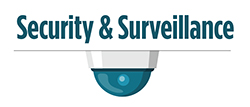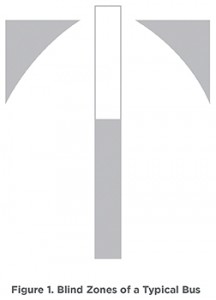
 Camera surveillance systems: Where’s the evidence?
Camera surveillance systems: Where’s the evidence?
By Colin Smith
Why do agencies use camera surveillance systems on buses? We can ultimately consolidate their uses into two major categories: enhancing visibility and affecting crime. While many providers tout these as true, we often lack evidentiary knowledge. Let’s examine further.
First, let’s examine the claim that cameras enhance visibility. The largest hindrance to clear visibility on buses is the presence of blind spots. Bus-specific blind spots are large and typically appear directly behind the vehicle for an extended distance and to either side of the front-portion of the bus, as can be seen in Figure 1.
While the rear blind-spot produces the most obstructed view, it is not of much importance – buses are rarely required to back up in the course of their daily routes. Thus, the two side blind-spots that remain are a safety concern. The claim that rear blind-spots take precedence over side blind-spots is supported by data from the Florida Crash Analysis Reporting (CAR) System. Although back-up crashes only caused 5.76 percent of at-fault bus crashes, sideswipe and side-related crashes made up 39.96 percent. Likewise, the Side Object Detection System (SODS) found only 19 percent of crashes occur in the rear and 46 percent on the side. Once more, data from a third study, Dunn et al., suggests 30 percent of crashes occur between the front and the rear while 44 percent are attributed to angle crashes or sideswipes. These data clearly identify where visibility is lacking – the sides of buses.
The Florida Department of Transportation (FDT) found that camera systems (cameras and a viewing monitor) present a viable solution to overcoming side blind-spots. By comparing flat mirrors, convex mirrors, regular-angle lenses and wide-angle lenses, the FDT found that with proper placement and adequate fields of view, cameras can eliminate 100 percent of the side blind-spot obstructions that remain with traditional, flat mirrors. Thus, it can be concluded that the use of cameras does enhance the visibility drivers need to maintain a safe environment by, at the least, eliminating side blind-spots.
Second, let’s examine the claim that camera systems affect crime. Most would suggest that cameras affect crime by deterring it. Anecdotal evidence in support of this claim is prevalent and signs such as “You are Being Recorded” bolster its supposed logic. However, the evidence does not paint such a simple picture. Through his literature review, Cavoukian (2008) found extreme variations in the results of studies that measured reductions in criminal activity from the implementation of camera systems; as well, each study maintained a different degree of rigor, rendering inaccurate comparison data. Why the variations?
It is difficult to measure reductions in criminal activity on transportation buses because of the chaotic nature of public settings – it is impossible to exclude extraneous variables for capturing untainted measurements. Also, crime rates vary from location to location, fluctuate sporadically and range in intensity, meaning a reduction in crime cannot be solely attributed to the implementation of camera systems. While Cavoukian ultimately concluded that camera systems do prevent some crimes, accurately measuring and tracking those reductions is difficult. There is correlation, but a lack of causation.
Although cameras deter criminal activity, their main benefit lies in post-incident activities such as criminal investigations. Camera systems create a trove of video evidence, offering law enforcement the ability to confidently place a person at a particular location, on a particular date and at a particular time. With decreasing data storage costs and improving camera imagery, camera systems will increasingly be used for these purposes. It can be seen that the use of camera systems does affect criminal activity by deterring criminal behavior and by assisting with post-incident activities.
In conclusion, camera surveillance systems are producing real results, bolstering the two claims originally made in this piece – that they enhance visibility and affect crime. While it is commonplace for those in the mobile surveillance industry to tout these two claims, the readers of this article are now armed with the evidentiary knowledge to back them up.
Colin Smith, M.P.A., is the marketing manager for Safety Vision, LLC, a pioneer in mobile video surveillance systems. Safety Vision prides itself on its institutional knowledge. Visit Safety Vision at www.safetyvision.com. For a complete set of references please visit: http://bit.ly/1IwdQCu
